Abstract
We evaluated a prototype polymerase chain reaction (PCR)-based assay for Chlamydia trachomatis developed by Roche Molecular Systems to detect endocervical infection in women. Of 587 endocervical samples obtained from women attending the Harborview Medical Center sexually transmitted diseases clinic, 58 (10%) were positive for C. trachomatis by cell culture. Compared with culture, the PCR method had a sensitivity of 88% (51 of 58) and a specificity of 99.2% (525 of 529). The positive and negative predictive values were 92.7% (51 of 55) and 98.7% (525 of 532), respectively. After resolution of discrepant results whereby true positives were considered to be either culture-positive patients (58 patients) or culture-negative patients positive upon PCR analysis using both plasmid- and major outer membrane protein-based primers (4 patients), the resolved sensitivities of the PCR and culture were 89 and 93%, respectively. We subsequently performed a second analysis of 362 women, comparing the proposed commercial PCR assay from Roche Molecular Systems with chlamydia cultures. Thirty (8%) women were infected with C. trachomatis. Compared with culture, the assay had a sensitivity of 60% (18 of 30) and a specificity of 99% (328 of 332). Repeat PCR assay done 2 to 5 days later subsequently yielded positive results for 7 of 11 PCR-negative samples from culture-positive women. We conclude that the Roche Molecular Systems PCR assay provides highly specific results compared with culture in a high-risk population of women. Further study is needed, however, to more clearly define the sensitivity of the PCR assay in detecting endocervical C. trachomatis infection in women and to identify factors that may compromise sensitivity.
Full text
PDF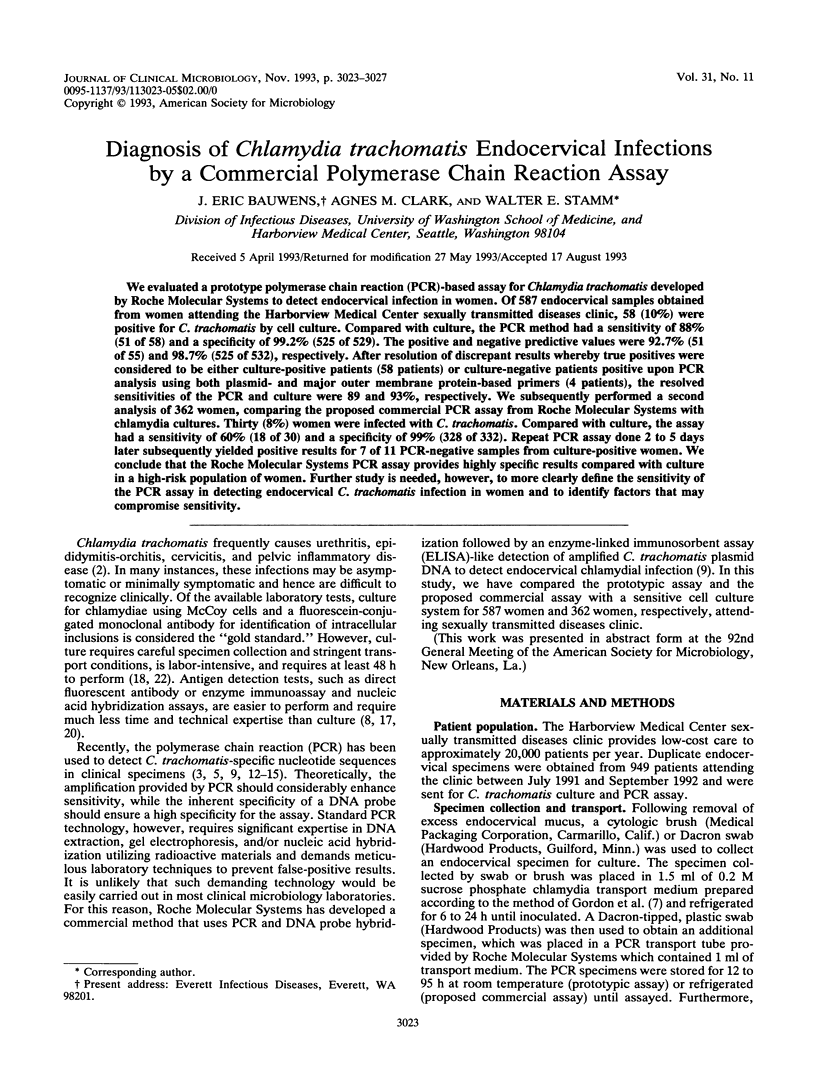
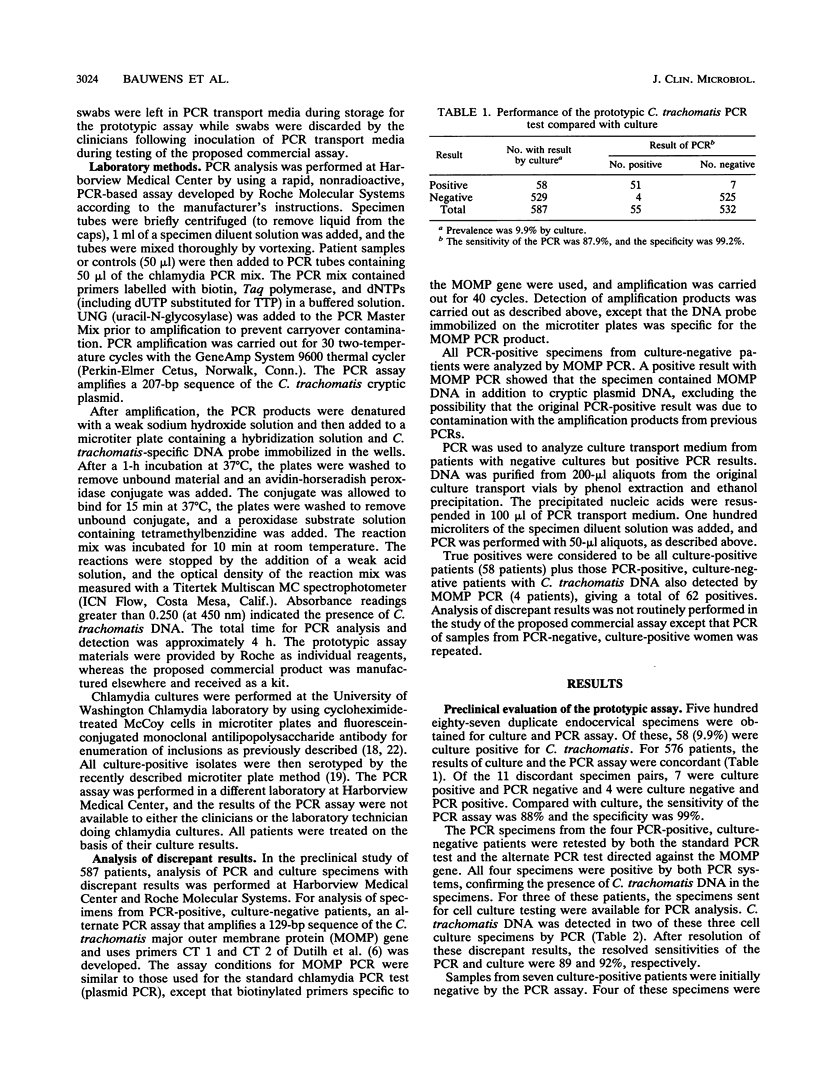
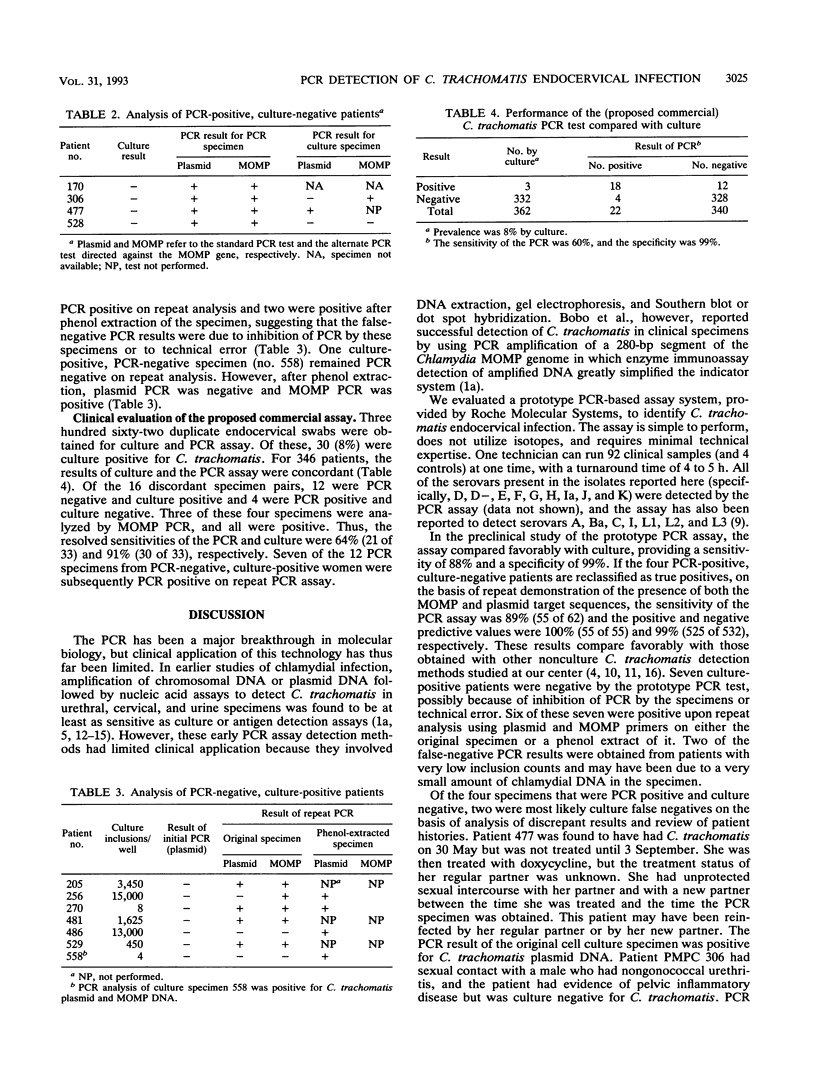
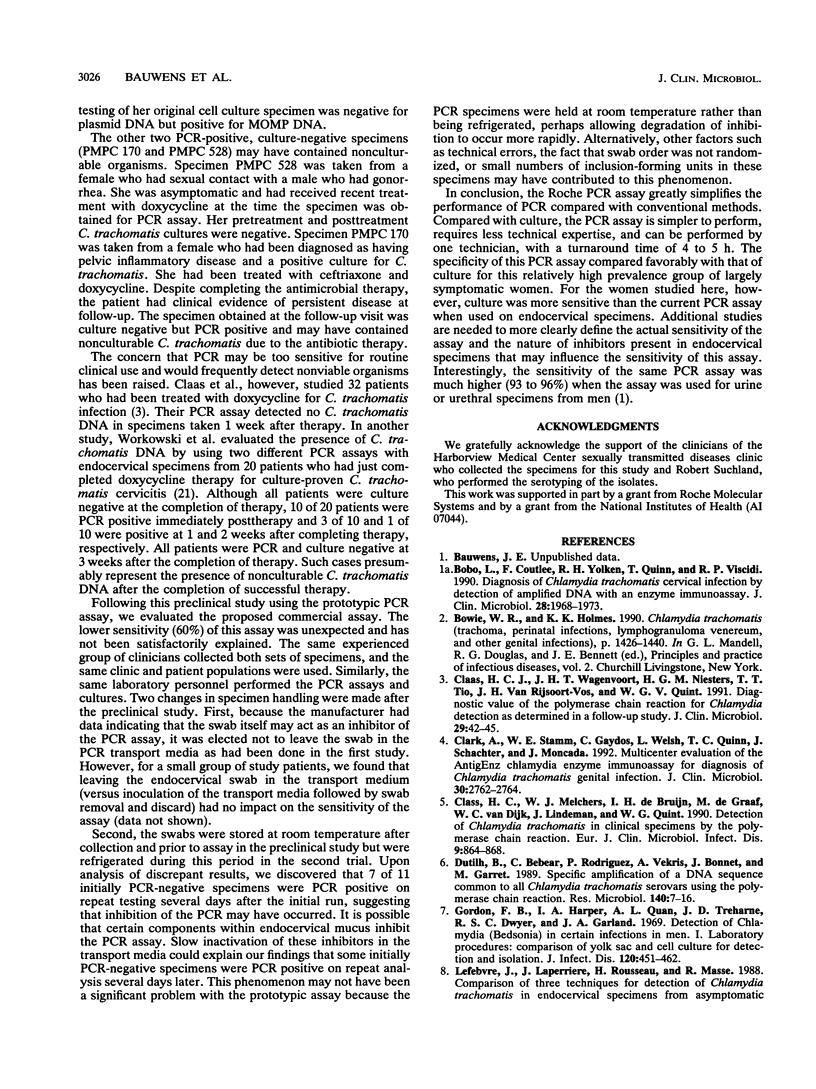
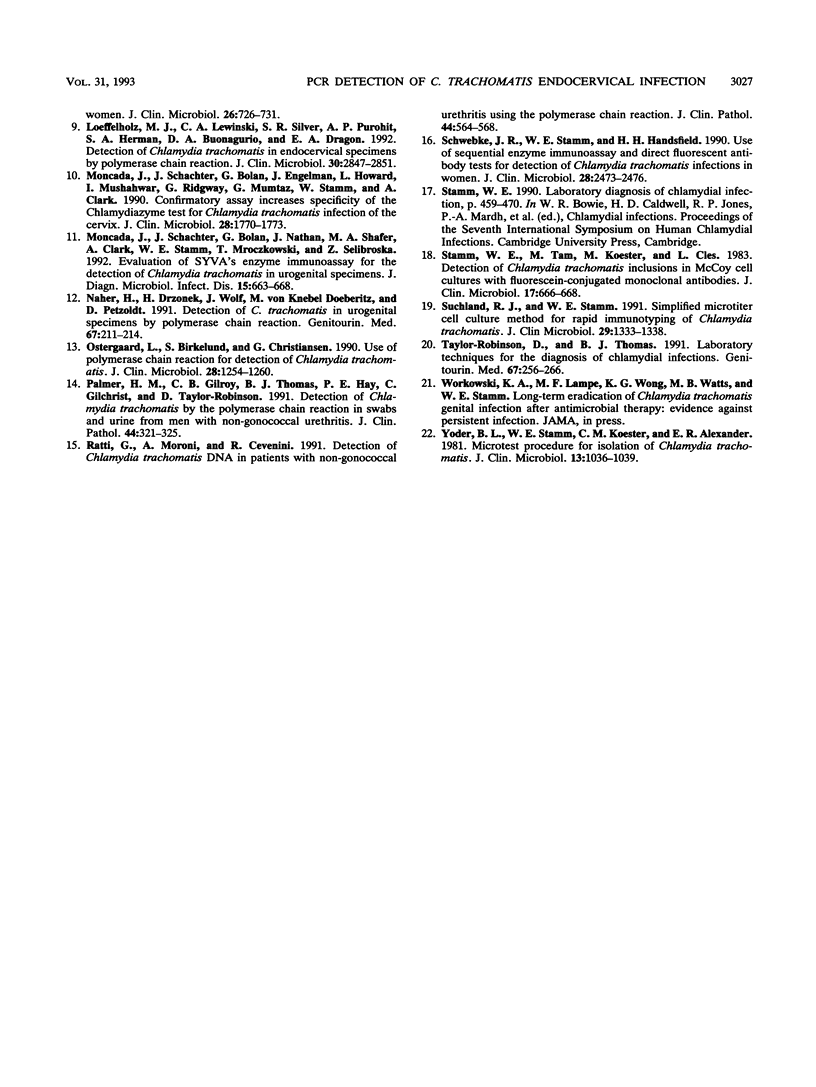
Selected References
These references are in PubMed. This may not be the complete list of references from this article.
- Bobo L., Coutlee F., Yolken R. H., Quinn T., Viscidi R. P. Diagnosis of Chlamydia trachomatis cervical infection by detection of amplified DNA with an enzyme immunoassay. J Clin Microbiol. 1990 Sep;28(9):1968–1973. doi: 10.1128/jcm.28.9.1968-1973.1990. [DOI] [PMC free article] [PubMed] [Google Scholar]
- Claas H. C., Melchers W. J., de Bruijn I. H., de Graaf M., van Dijk W. C., Lindeman J., Quint W. G. Detection of Chlamydia trachomatis in clinical specimens by the polymerase chain reaction. Eur J Clin Microbiol Infect Dis. 1990 Dec;9(12):864–868. doi: 10.1007/BF01967500. [DOI] [PubMed] [Google Scholar]
- Claas H. C., Wagenvoort J. H., Niesters H. G., Tio T. T., Van Rijsoort-Vos J. H., Quint W. G. Diagnostic value of the polymerase chain reaction for Chlamydia detection as determined in a follow-up study. J Clin Microbiol. 1991 Jan;29(1):42–45. doi: 10.1128/jcm.29.1.42-45.1991. [DOI] [PMC free article] [PubMed] [Google Scholar]
- Clark A., Stamm W. E., Gaydos C., Welsh L., Quinn T. C., Schachter J., Moncada J. Multicenter evaluation of the AntigEnz Chlamydia enzyme immunoassay for diagnosis of Chlamydia trachomatis genital infection. J Clin Microbiol. 1992 Nov;30(11):2762–2764. doi: 10.1128/jcm.30.11.2762-2764.1992. [DOI] [PMC free article] [PubMed] [Google Scholar]
- Dutilh B., Bébéar C., Rodriguez P., Vekris A., Bonnet J., Garret M. Specific amplification of a DNA sequence common to all Chlamydia trachomatis serovars using the polymerase chain reaction. Res Microbiol. 1989 Jan;140(1):7–16. doi: 10.1016/0923-2508(89)90053-3. [DOI] [PubMed] [Google Scholar]
- Gordon F. B., Harper I. A., Quan A. L., Treharne J. D., Dwyer R. S., Garland J. A. Detection of Chlamydia (Bedsonia) in certain infections of man. I. Laboratory procedures: comparison of yolk sac and cell culture for detection and isolation. J Infect Dis. 1969 Oct;120(4):451–462. doi: 10.1093/infdis/120.4.451. [DOI] [PubMed] [Google Scholar]
- Lefebvre J., Laperrière H., Rousseau H., Massé R. Comparison of three techniques for detection of Chlamydia trachomatis in endocervical specimens from asymptomatic women. J Clin Microbiol. 1988 Apr;26(4):726–731. doi: 10.1128/jcm.26.4.726-731.1988. [DOI] [PMC free article] [PubMed] [Google Scholar]
- Loeffelholz M. J., Lewinski C. A., Silver S. R., Purohit A. P., Herman S. A., Buonagurio D. A., Dragon E. A. Detection of Chlamydia trachomatis in endocervical specimens by polymerase chain reaction. J Clin Microbiol. 1992 Nov;30(11):2847–2851. doi: 10.1128/jcm.30.11.2847-2851.1992. [DOI] [PMC free article] [PubMed] [Google Scholar]
- Moncada J., Schachter J., Bolan G., Engelman J., Howard L., Mushahwar I., Ridgway G., Mumtaz G., Stamm W., Clark A. Confirmatory assay increases specificity of the chlamydiazyme test for Chlamydia trachomatis infection of the cervix. J Clin Microbiol. 1990 Aug;28(8):1770–1773. doi: 10.1128/jcm.28.8.1770-1773.1990. [DOI] [PMC free article] [PubMed] [Google Scholar]
- Moncada J., Schachter J., Bolan G., Nathan J., Shafer M. A., Clark A., Schwebke J., Stamm W., Mroczkowski T., Seliborska Z. Evaluation of Syva's enzyme immunoassay for the detection of Chlamydia trachomatis in urogenital specimens. Diagn Microbiol Infect Dis. 1992 Nov-Dec;15(8):663–668. doi: 10.1016/0732-8893(92)90068-5. [DOI] [PubMed] [Google Scholar]
- Näher H., Drzonek H., Wolf J., von Knebel Doeberitz M., Petzoldt D. Detection of C trachomatis in urogenital specimens by polymerase chain reaction. Genitourin Med. 1991 Jun;67(3):211–214. doi: 10.1136/sti.67.3.211. [DOI] [PMC free article] [PubMed] [Google Scholar]
- Ostergaard L., Birkelund S., Christiansen G. Use of polymerase chain reaction for detection of Chlamydia trachomatis. J Clin Microbiol. 1990 Jun;28(6):1254–1260. doi: 10.1128/jcm.28.6.1254-1260.1990. [DOI] [PMC free article] [PubMed] [Google Scholar]
- Palmer H. M., Gilroy C. B., Thomas B. J., Hay P. E., Gilchrist C., Taylor-Robinson D. Detection of Chlamydia trachomatis by the polymerase chain reaction in swabs and urine from men with non-gonococcal urethritis. J Clin Pathol. 1991 Apr;44(4):321–325. doi: 10.1136/jcp.44.4.321. [DOI] [PMC free article] [PubMed] [Google Scholar]
- Ratti G., Moroni A., Cevenini R. Detection of Chlamydia trachomatis DNA in patients with non-gonococcal urethritis using the polymerase chain reaction. J Clin Pathol. 1991 Jul;44(7):564–568. doi: 10.1136/jcp.44.7.564. [DOI] [PMC free article] [PubMed] [Google Scholar]
- Schwebke J. R., Stamm W. E., Handsfield H. H. Use of sequential enzyme immunoassay and direct fluorescent antibody tests for detection of Chlamydia trachomatis infections in women. J Clin Microbiol. 1990 Nov;28(11):2473–2476. doi: 10.1128/jcm.28.11.2473-2476.1990. [DOI] [PMC free article] [PubMed] [Google Scholar]
- Stamm W. E., Tam M., Koester M., Cles L. Detection of Chlamydia trachomatis inclusions in Mccoy cell cultures with fluorescein-conjugated monoclonal antibodies. J Clin Microbiol. 1983 Apr;17(4):666–668. doi: 10.1128/jcm.17.4.666-668.1983. [DOI] [PMC free article] [PubMed] [Google Scholar]
- Suchland R. J., Stamm W. E. Simplified microtiter cell culture method for rapid immunotyping of Chlamydia trachomatis. J Clin Microbiol. 1991 Jul;29(7):1333–1338. doi: 10.1128/jcm.29.7.1333-1338.1991. [DOI] [PMC free article] [PubMed] [Google Scholar]
- Taylor-Robinson D., Thomas B. J. Laboratory techniques for the diagnosis of chlamydial infections. Genitourin Med. 1991 Jun;67(3):256–266. doi: 10.1136/sti.67.3.256. [DOI] [PMC free article] [PubMed] [Google Scholar]
- Yoder B. L., Stamm W. E., Koester C. M., Alexander E. R. Microtest procedure for isolation of Chlamydia trachomatis. J Clin Microbiol. 1981 Jun;13(6):1036–1039. doi: 10.1128/jcm.13.6.1036-1039.1981. [DOI] [PMC free article] [PubMed] [Google Scholar]


